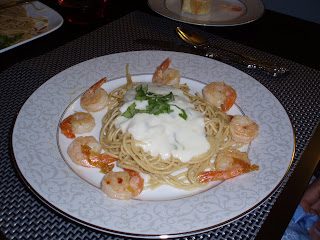Think of this as something similar to Emeril's famous Essence or the famous Louisiana BBQ spice rubs. Only difference, the concoctions I'm going to share date back to the
Mughal period, when
dishes created for royalty became popular and eventually common among the Muslim households. Some of these masaala (spice) mixes are also a melding of the Muslim and Hindu cultures, which coincided in the Sub-continent (what is now South Asia). Certain spices are common in the Hindu way of cooking and some (mostly those for meat dishes) are particular to the Muslim style of cooking and an influence from the Persians and Turks.
I will share with you some common masaala's which you can use to create a number of different Desi dishes. Remember from my
last post on basics, I explained the concept of bhagaar...well these spices are usually added to warm oil at the start of cooking, thus creating the base.
"Phorran" is an old term used to describe a certain spice mix, but the literal translation of the word is prescription or recipe (as relating to medicine). "
Panch (#5) Phorran" is a spice mix of five spices, often used for certain types of vegetables and chicken, but can be adapted for cooking some meat curry's as well. The more common term for Panch Phorran is
Achar ka Masaala (pickling spices); most Desi people today would know the term Achaar (pickle) since they use the condiment regularly with meals, eg. Aamn ka Achaar (mango pickle), Nimbo ka Achaar (lemon/lime pickle), etc. The five spices required for achaar ka masaala are:
Zeera (cumin seed) (do not confuse with caraway)
Sonph (fennel seed)
Kalonji (Nigella seed) (do not confuse with onion seed or black sesame)
Rai (Brown Mustard seed)
Mehthi Dana (Fenugreek)
When cooking with these spices, you would traditionally use equal parts of each spice. I often use more zeera and avoid the use of mehthi because of its bitter taste and side affects (you can smell it in your sweat and urine for a few days after). Also note, many of the spices (depending on the dish) are used either whole or ground. This particular spice mix is never used ground...always whole.
Garam Masaala is a very common spice mix in Desi cooking. Today you will find it available in some larger grocery stores in a ground form, not just in Indian stores. This mix can be used whole or ground and often times is also used as a garnish, not just a base. The word "Garam" means "hot" and this relates directly to the nature of the spices in this mix. All of the spices in this mix are by nature hot.
In traditional Desi cooking, there is a belief that all ingredients (fruits, vegetables, herbs, spices, meats, etc.) have a certain "taseer" (genetic makeup or nature) to them. Some things are hot by nature, some are cold, some are soothing while others are acidic or indigestion inducing. There is a whole science and logic behind Desi cooking and a lot of it has to do with the nature of ingredients, thus what should be mixed with what and what should never be mixed with something, etc. The concepts are similar to the western logic of some vegetables being meant for summer consumption while others are meant for winter...it is based on their nature or the effect they have on our body once consumed. The spices required for garam masaala are:
Zeera
Kali/Gol Mirch (whole black pepper)
Long (whole cloves)
Sabuth
Dhaniya (corriander seed)
Barri Ilaychi (large black cardamom)
Daal Cheeni (cinnamon stick)
For every day cooking I will use this mix whole but without barri ilaychi and sometimes without the cinnamon (depending on what I'm making and the time of year). Many times I'll use it ground as a garnish, but again without the barri ilaychi since it has a very strong taste. In some dishes you can substitute the barri ilaychi for choti ilaychi which is green cardamom, for example when making
pulao. Some people also like to add bay leaf into this mix which is nice for some rice dishes and curry's but not traditional in the garaam masaala you can pre-mix and keep for regular use.
Gosht ka Masaala, "Gosht" refers to red meats like beef, lamb and goat. This masaala is used to make traditional Muslim meat curry's (gosht ka salaan). Murghi (chicken) and Machli (fish) salaan's get different spices, so be careful as not to use this for white meats...the spices will be over powering. Salaan is usually made with onion and garlic, gosht ka salaan also gets ginger and either tomato or yogurt; plus the spices I'm about to list out. Gosht ka Masaala is:
Haldi (ground tumeric)
Laal Mirch (cayenne or red chili powder)
Salt
Kali/Gol Mirch
Long
Pissa Dhaniya (ground or powder corriander seed)
Pissa Zeera (ground or powder cumin seed)
(some people like to add cinnamon but its not traditional)
Well I will leave you with these basic masaalas for now and write up some more traditional concoctions for you later. As always, if you have any questions/concerns don't hesitate to reach out.
Good luck and be creative!






